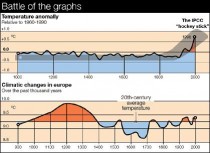Paul Driessen
Presidential candidate Barack Obama promised that his policies would cause electricity rates to “skyrocket” and “bankrupt” any company trying to build a coal-fired generating plant. This is one promise he and his uber-regulators are keeping.
President Obama energetically promotes wind and solar projects that require millions of acres of land and billions of dollars in subsidies, to generate expensive, intermittent electricity and create jobs that cost taxpayers upwards of $220,000 apiece - most of them in China.
His Interior Department is locking up more coal and petroleum prospects, via “wild lands” and other designations, and dragging its feet on issuing leases and drilling permits. Meanwhile, his Environmental Protection Agency is challenging shale gas drilling and fracking, and imposing draconian carbon dioxide emission rules, now that Congress and voters have rejected cap-tax-and-trade. That’s for starters.
The beat-down of hydrocarbon energy goes on. Oil, gas and coal provide 85% of the energy that keeps America humming, but the administration is doing all it can to take it out of our mix. American voters, consumers and workers may want more drilling, mining and use of hydrocarbons, to get the economy going again. But the administration has a different agenda.
EPA Administrator Lisa Jackson has unveiled another 946 pages of regulations that she claims will protect public health. The regs cover 84 “dangerous pollutants” that are already being scrubbed out of power plant emission streams by a host of innovative technologies. In fact, coal-fired generators now emit a fraction of what they did just 40 years ago.
The most frequently cited of these pollutants is mercury. Higher doses cause well-known ill-health effects, from severe neurological damage to brain damage and death. However, it has been all but eliminated in herbicides, light switches, thermometers and other products.
Its presence in coal and power plant emissions is likewise minimal and declining. The last serious cases of human health impacts from mercury poisoning in the US occurred decades ago - and coal-fired power plants remain the largest source of US-based manmade mercury only because other human sources are essentially gone.
Nevertheless, EPA and its anti-energy, anti-job allies like Climate Progress and Greenpeace are using mercury to spearhead their latest campaign against a fuel that provides half of all US electricity, and up to 95% in many manufacturing states. Even worse, they claim minorities somehow are especially at risk from mercury and other power plant pollutants. They even went so far as to hold a people-of-color-only press conference, to stir up fears and persuade minority interest groups to support the new regulations.
A few elemental facts put the alleged “dangers” power plant mercury emissions in perspective - which EPA and its fellow campaigners steadfastly refuse to do. They also illustrate how EPA abuses science, statistics and tax-funded “education” campaigns to promote needless public anxiety and expand its control over our lives, jobs and consumer choices, on a host of pollutants that pose little actual risk.
First and foremost, we are talking about a mere 41 tons of mercury per year. If that sounds like a lot, consider the following.
The United Nations Environment Program estimates that the cremation of human remains results in 26 tons of atmospheric mercury per year - from mercury-silver amalgams in teeth fillings.
China’s coal-fired power plants emit six times more mercury than their US counterparts, and power plants worldwide emit nearly twelve times as much, according to UN and other data. Since the atmosphere, jet streams and weather systems are global phenomena, all this mercury is mixed with US emissions,
But even these manmade sources are dwarfed by natural sources.
According to the National Center for Atmospheric Research, forest fires in the Lower 48 States and Alaska annually put over 44 tons of mercury into the air. Root systems carry naturally occurring mercury from soils into their leaves and wood; forest fires release the mercury into the atmosphere and also “roast” it out of burned soils. (Maybe it’s time to ban forest fires - and wood-burning stoves.)
Recent studies by two Cambridge University scientists calculate that man and Mother Nature discharge up to 9100 tons of mercury into the global atmospheric every year. Most comes from volcanoes, but subsea vents (the Mid-Atlantic Ridge and elsewhere), geysers and forest fires also play major roles.
In other words, US power plants account for less than 0.5% of all the mercury in the air that we Americans breathe. Even eliminating every ounce of this mercury will do nothing about the other 99.5% of that pollutant in America’s atmosphere.
And yet EPA & Company demand that we do just that - at a cost of billions of dollars per year, to “protect” us from infinitesimal or imaginary risks.
Perhaps our helpful bureaucrats and activists could put a Plexiglass bubble over the entire United States, to keep those evil natural and Chinese gases out; plug Old Faithful and Kilauea; keep people (especially minorities) away from Yellowstone National Park; and ban curly mercury-enhanced CFL bulbs.
Add up everything EPA is doing to tax, obstruct and penalize coal use, and we are looking at huge increases in electricity prices. These skyrocketing prices will hammer family budgets, especially in minority communities, impairing nutrition and health, making it harder for many families to heat, cool and pay for their homes, and increasing illness and death.
Soaring energy prices will also force numerous companies to outsource manufacturing operations and jobs. Electricity is a major cost for factories, offices, stores, hospitals and schools. Every price hike hits them with another $10,000 to $1,000,000 or more in new annual expenses that they must pass on to consumers - or address by laying off more employees, whose families then suffer even more.
These hard realities must be viewed against 8.9% national, 11.6% Hispanic and 15.3% black joblessness. (These figures do not include people who have given up on finding a job, or have been forced to take part-time or temporary work.) EPA’s unelected and unaccountable bureaucrats are being completely disingenuous when they say their latest ten-pound stack of rules will bring one milligram of net benefit to human health and welfare, especially for minorities.
EPA’s special “stakeholder briefing” on March 16 certainly conveys the correct image. Environmental activist groups are holding the stake that this rogue agency intends to pound through the heart of America’s economic recovery and civil rights progress.
EPA needs to start basing its policies and rules on science, reality, common sense, and comprehensive public health considerations. Congress needs to reassert its authority over EPA.
Both need to focus on responsible, science-based air and water quality standards that address real health and economic needs - and recognize that “human health and welfare” means more than eliminating every vestige of US manmade emissions, especially when we can do absolutely nothing about the vast majority of natural and manmade global emissions.
America - and our economic and civil rights progress - are waiting.
Paul Driessen is senior policy advisor for the Congress of Racial Equality and Committee For A Constructive Tomorrow, and author of Eco-Imperialism: Green power - Black death.
Also today see this globalwarming.org post on Boxer’s tirade in committee against the McConnell amendment that would stifle EPA regluatory authority.
Boxer: “This [S. 493] is a first of a kind. It has never been done. It is essentially a repeal of the Clean Air Act as it involves one particular pollutant, carbon, which has been found to be an endangerment to our people.”
Predictably clueless or conniving or both
Jean Chemnick, E&E reporter
On the eve of today’s Senate vote to halt U.S. EPA’s climate change rules, environmentalists moved to blur the distinctions between three different amendments, saying all would strip needed public health safeguards.
It was a last-minute play to sway Senate Democrats, some of whom are likely to vote for one or more of the amendments to scale back EPA’s regulatory reach. An email sent out by the Sierra Club last night carried the apocalyptic subject line, “Will There Be a Clean Air Act Tomorrow?”
Senate Majority Leader Harry Reid (D-Nev.) said yesterday that he would bring three amendments to the Senate floor that deal with EPA’s climate rules, as part of the chamber’s consideration of a small business bill.
One of the amendments, by Senate Minority Leader Mitch McConnell (R-Ky.), would strip EPA of its greenhouse gas regulatory authority altogether save for a temporary exemption for tailpipe emissions rules.
The McConnell amendment, based on a bill by Sen. James Inhofe (R-Okla.), is expected to draw the support of most of the Senate’s Republicans. “I would expect we would get most of ours and hopefully some of theirs,” said South Dakota Sen. John Thune, the No. 4 Republican in the chamber.
Democrats plan to bring two Senate Democratic amendments to the floor as alternatives to McConnell’s proposal. The most likely candidates were amendments proposed by Sen. Jay Rockefeller (D-W.Va.), which would delay for two years EPA’s current and future climate change rules for stationary sources like electric utilities and manufacturing facilities, and by Sen. Max Baucus (D-Mont.), which would uphold EPA’s tailoring rule but with some additional limitations related to New Source Review rules and renewable fuel standards. Sen. Debbie Stabenow (D-Mich.) has also crafted an EPA amendment, but no details were available on it yesterday. Stabenow is the one who a few years ago said she could feel the bumps from global warming when she flew in a plane.
The amendments differ broadly in what they would do—McConnell’s would eliminate EPA’s greenhouse gas program, while Baucus’ would make some significant changes but leave EPA’s carbon rules largely intact. But environmental advocates argued that none of them would represent a positive step.
“A vote for the McConnell, Baucus or Rockefeller Clean Air Act attacks would be a vote to sacrifice the health and well-being of Americans on the mantle of bigger profits for polluter giants like Exxon Mobil,” said Erich Pica, president of Friends of the Earth.
“Just as no sane person would respond to a robbery by handcuffing the police, no honest senator would respond to the climate crisis by handcuffing the most powerful agent for solving it,” Pica added.
The left-leaning (Icecap Note: not leaning - long since toppled over) Center for American Progress yesterday also raised the alarm about the upcoming Senate votes. “The Senate should oppose efforts to block protection of public health from threats posed by carbon dioxide pollution,” the group said in a statement. “Preventing the EPA from doing its job will risk the health of children, seniors, and those suffering from respiratory ailments. These amendments would also discourage investments in innovative clean energy technologies.”
Senate Environment and Public Works Chairwoman Barbara Boxer (D-Calif.) said that McConnell’s amendment was her main worry, but she is unlikely to support any of the proposals, though she conceded that she had not yet examined the Baucus amendment. “I’m opposed to delay, because the more you delay the more dangerous it is—the more carbon you release into the atmosphere,” Boxer said.
ICECAP NOTE: Boxer shows she is still either clueless or conniving (or a dangerous combination of both). She uses carbon instead of carbon dioxide, implying flyash and soot. There is no trading of soot or flyash in the carbon markets. The governments of the world have been targeting CO2 because that is where the money is. They are paying big dollars to scientists to provide cover for their power grabbing schemes.
The enviros play fast and loose with the facts implying health risks for the elderly and children with asthma. We have done a great job improving air and water quality over the recent decades. We no longer have to drive behind clunkers and buses or trucks that emit noxious fumes with particulates, carbon MONOXIDE, nitrous oxides and hydrocarbons. We always stated that our goal was to get to the point where combustion of fossil fuels in factories and autos produce mainly the harmless gases - CO2 and water vapor. We are largely there. We don’t need the EPA imposing unnecessary, extremely costly and regulations that will harm the private industry and the public with greatest harm to the poor, many of whom will not be able to afford the costs of energy and foods that will rise as a result of the enviro and EPA plans. We hope the senate has the courage to say no to Boxer and Reid and move to wrestle away control from the EPA.
Hockey Schtick
Spinmeister Michael Mann has fired off a reply to the editor of a newspaper which published an article critical of his work, again claiming his hockey stick graph, one of the most thoroughly discredited papers of the modern age, was affirmed by the National Academy of Sciences (NAS):
“...the National Academy of Sciences, affirmed my research findings in an exhaustive independent review published in June 2006..”
The NAS report did nothing of the sort, and in fact validated all of the significant criticisms of McIntyre & McKitrick (M&M) and the Wegman Report:
1. The NAS indicated that the hockey stick method systematically underestimated the uncertainties in the data (p. 107).
2. In subtle wording, the NAS agreed with the M&M assertion that the hockey stick had no statistical significance, and was no more informative about the distant past than a table of random numbers. The NAS found that Mann’s methods had no validation (CE) skill significantly different from zero. In the past, however, it has always been claimed that the method has a significant nonzero validation skill. Methods without a validation skill are usually considered useless. Mann’s data set does not have enough information to verify its ‘skill’ at resolving the past, and has such wide uncertainty bounds as to be no better than the simple mean of the data (p. 91). M&M said that the appearance of significance was created by ignoring all but one type of test score, thereby failing to quantify all the relevant uncertainties. The NAS agreed (p. 110), but, again, did so in subtle wording.
3. M&M argued that the hockey stick relied for its shape on the inclusion of a small set of invalid proxy data (called bristlecone, or “strip-bark” records). If they are removed, the conclusion that the 20th century is unusually warm compared to the pre-1450 interval is reversed. Hence the conclusion of unique late 20th century warmth is not robust - in other word it does not hold up under minor variations in data or methods. The NAS panel agreed, saying Mannís results are “strongly dependent” on the strip-bark data (pp. 106-107), and they went further, warning that strip-bark data should not be used in this type of research (p. 50).
4. The NAS said “ Mann et al. used a type of principal component analysis that tends to bias the shape of the reconstructions”, i.e. produce hockey sticks from baseball statistics, telephone book numbers, and monte carlo random numbers.
5. The NAS said Mann downplayed the “uncertainties of the published reconstructions...Even less confidence can be placed in the original conclusions by Mann et al. (1999) that ‘the 1990s are likely the warmest decade, and 1998 the warmest year, in at least a millennium.”
Mann never mentions that a subsequent House Energy and Commerce Committee report chaired by Edward Wegman totally destroyed the credibility of the ‘hockey stick’ and devastatingly ripped apart Mann’s methodology as ‘bad mathematics’. Furthermore, when Gerald North, the chairman of the NAS panel—which Mann claims ‘vindicated him’ - was asked at the House Committee hearings whether or not they agreed with Wegman’s harsh criticisms, he said they did:
CHAIRMAN BARTON: Dr. North, do you dispute the conclusions or the methodology of Dr. Wegman’s report?
DR. NORTH [Head of the NAS panel]: No, we don’t. We don’t disagree with their criticism. In fact, pretty much the same thing is said in our report.
DR. BLOOMFIELD [Head of the Royal Statistical Society]: Our committee reviewed the methodology used by Dr. Mann and his co-workers and we felt that some of the choices they made were inappropriate. We had much the same misgivings about his work that was documented at much greater length by Dr. Wegman.
WALLACE [of the American Statistical Association]: ‘the two reports [Wegman’s and NAS] were complementary, and to the extent that they overlapped, the conclusions were quite consistent.’ Mann uses the 5 rules of propaganda in his defense, including the rule of orchestration: endlessly repeating the same messages in different variations and combinations [e.g. the NAS gave my hockey stick a clean bill of health].



